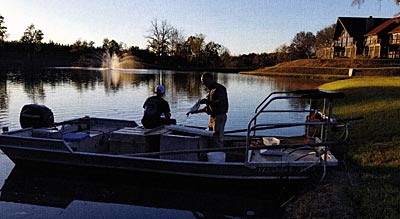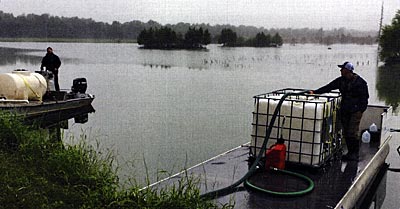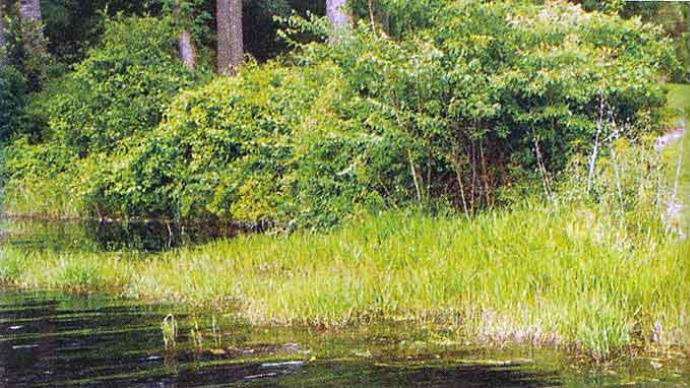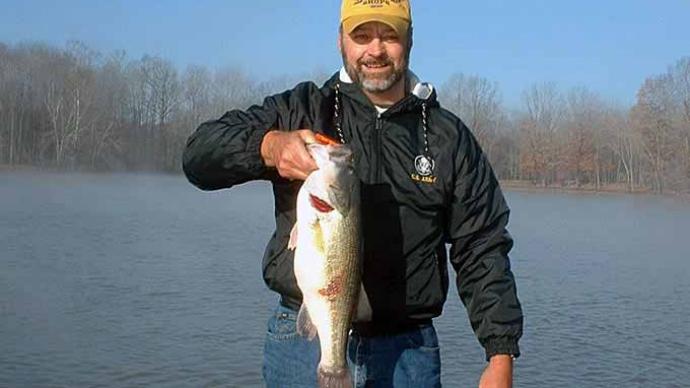
As you step outside on the first crisp fall morning of the year, your skin is greeted by a cooler temperature while that first breath of clean air fills your lungs. It is an ideal season that includes both refreshing morning air as well as the warmth of the afternoon sun. Fall weather also brings cooler water temperatures that provide Largemouth bass with ideal growing conditions. As a result, fall is a great time of year to focus on strategic fisheries management methods that boost bass growth. Unfortunately, most people who manage for trophy bass fishing fail to take full advantage of the opportunity. In many cases, bass fishing is simply a lower priority than hunting.
Effective fall fisheries work requires a balance between collecting and analyzing data, strategic planning, and carrying out management tasks. It is critical to review the year's data collectively and compare it to data from previous years. It's also important to review and compare this information with your projected data for the year based on the management strategies implemented. To analyze accurately, consider both creel and electrofishing data, water quality data, and age and growth data (if its available). Team this with knowledge of the fisheries habitat and any other key observations that may have influenced the fishery or the data, such as abnormal weather.
This data shows a bigger picture of how your fishery is progressing and should drive the fall's management decisions. Even though priority changes or an uncertain budget keeps you from finalizing your management strategies for the coming 12 months, do something. It's best to avoid falling into the trap of simply doing what you have been doing. Use your new data to make important short-term adjustments before water temperatures become cold, rather than applying it next spring. Delaying certain improvements can have a significant negative impact on the overall growth of predator fish when it is compounded over the lifetime of the fish.
One important fall improvement often put off for later is to continue to harvest intermediate size bass. Fall is a perfect time to start removing additional small bass beyond your yearly harvest quota and prevent them from consuming forage all fall and winter. Catching these bass can be more challenging this time of year. They are smaller and do not line up predictably along the shoreline as they do in the warmer spring months. Despite that, removing them annually in the fall or winter will have a compounding effect on the forage base as well as the growth rates of the remaining bass. When doing so, maintain detailed records of how many you harvest and their sizes. If done properly, this data will become an important data set to reflect on over the years when making management decisions.
Additionally, it's important to focus on water quality data collected throughout the year. Although water quality should always be analyzed in real time, review all the data and observations you've collected through the spring, summer, and early fall. Addressing low alkalinity issues and high phosphorus issues in the colder months is common, and a good idea. The process of applying lime (to improve alkalinity) or products such as alum or Phoslock (to bind with phosphorus) can inadvertently pull desired plankton out of the water column. This might temporarily restrict forage fish production. Likewise, in some cases, adding lime can greatly increase the amount of phosphorus available in the water column. If this is done in warmer months, the process is capable of fueling intense algae blooms that can deplete oxygen, stress fish, and be expensive to control. Depending on the situation, it may make sense to complete this work during the growing season, but cooler months are generally preferred. Only in rare instances should management tasks of this nature be delayed until the following spring or summer.

Another water quality improvement that can be completed in the cooler months is the addition of bottom diffused aeration. Maintaining ample dissolved oxygen throughout the water column and the sediment-water interface has many benefits, including mixing of beneficial algae species, improved dissolved oxygen, and reduced recycling of phosphorus into the water column from the waterbody's sediment layer. As a result, the sooner you start aerating, the sooner your fishery will start to see the benefits aeration provides.
Although it is not commonly thought of during the cooler months, some species of bluegreen algae thrive in cooler water and are an issue for fisheries throughout the fall and winter. Bluegreen algae is bad for both fish production as well as humans and other wildlife. Stay vigilant and maintain a low tolerance for bluegreen algae. When in doubt, test your water to identify the algae present. Life is too precious to have a high tolerance for the presence of these toxin producers.
If you do not have electrofishing, creel, and water quality data to confirm the condition of your fishery, start collecting this data. It needs to be part of your management strategy. Doing so will keep you aware of the variables limiting the fishery's success. Some improvements are best made in the cooler months, but data can be collected year-round. For example, identifying high phosphorus and low dissolved oxygen levels is often easiest in the summer, since those parameters are typically at their worst at that time of year. Consult with a professional if you are not certain what time of year to collect data as well as how much data to collect based on your goals and budget.
Data-driven management strategies help to ensure high odds of success, but not all cool weather management tasks require extensive data to implement. Nuisance wildlife management, for instance, is an extremely important task that is often overlooked. Many people do not recognize how much nuisance wildlife can detract from their fishery. I have seen first-hand the devastation caused by otters and cormorants. In most cases, the owners or property managers were either unaware of the predator's presence or did not realize the extent of the issue. Well-managed, thriving fisheries are a magnet for other fish-eating predators. You should maintain a consistent monitoring program throughout the fall and winter to identify issues before the fishery is negatively impacted.
As for a simple task, remove all batteries from feeders that are not being used in the winter. Charge them up in the shop and then reinstall them once you're ready to start feeding again. It is common to replace batteries after two years of use to ensure the feeder stays reliable.
Other equipment maintenance that should be considered is changing or cleaning out the air filters on your bottom diffused aeration system. If you have a 120-volt plug nearby or inside the cabinet, use a shop vac to vacuum out the compressor cabinet. Maintaining a clean cabinet helps to keep the air filters clean and can help to extend the life of the compressors. If you are using a serviceable volcano aerator or if you have a fountain, fall is a great time to perform the three-year oil and seals service.
Other more common improvements include stocking forage fish such as trout or Golden Shiners. Work with a biologist to set stocking rates based on your goals and budget. Improving fish cover is another common activity that can be completed in the cooler months. Try to do all tasks requiring you to get in the water while the water is still warm. If your fishery needs cover, be sure to complete it before fish spawn in the spring. Delaying until the following summer will limit the fishery's ability to thrive. In future years, you can plan ahead better and knock this out in the summer. Resist the urge to let chilly water prevent you from doing what is right for the fishery.
Fall is a great time of year for both outdoor enthusiasts as well as Largemouth bass. Do your best to avoid the mindset that spring and summer are the best time for fisheries improvements, and stay focused on your lake or pond throughout the cooler months. Managers and biologists that focus on fisheries management strategies year-round are positioned to produce fisheries with more potential than those that do not.
David Beasley is a Fisheries Biologist and the Director of Fisheries at SOLitude Lake Management, an environmental firm providing sustainable lake, pond, wetland and fisheries management services. Learn more about this topic at www.solitudelakemanagement.com/knowledge
Reprinted with permission from Pond Boss Magazine



